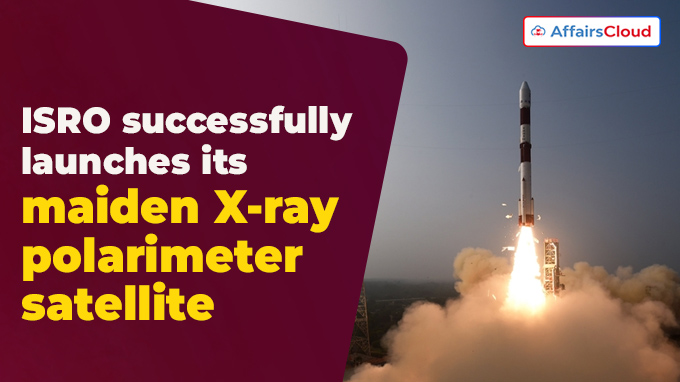 On 1st January 2024, Indian Space Research Organisation (ISRO) launched XPoSat (X-ray Polarimeter Satellite), India’s 1st dedicated polarimetry mission onboard the Polar Satellite Launch Vehicle (PSLV)-C58 from Satish Dhawan Space Centre in Sriharikota, Andhra Pradesh (AP). PSLV-C58 has launched XPOSAT Satellite into an Eastward low inclination orbit.
On 1st January 2024, Indian Space Research Organisation (ISRO) launched XPoSat (X-ray Polarimeter Satellite), India’s 1st dedicated polarimetry mission onboard the Polar Satellite Launch Vehicle (PSLV)-C58 from Satish Dhawan Space Centre in Sriharikota, Andhra Pradesh (AP). PSLV-C58 has launched XPOSAT Satellite into an Eastward low inclination orbit.
- It was PSLV-C58’s 60th mission and lifted a mass of 260 ton. It should be noted that this launch was by PSLV-DL variant. It was PSLV-DL’s 4th mission.
- The satellite is expected to operate for at least 5 years.
About XPoSAT/PSLV-C58 Mission:
i.The mission aims to study various dynamics of bright astronomical X-ray sources like blackhole, neutron stars, active galactic nuclei, pulsar wind nebulae etc. in extreme conditions.
ii.With this, India becomes the 2nd country in the world (after the United States of America(USA)) to launch a specialised astronomy observatory to study black holes and neutron stars in our galaxy.
Highlight of Mission:
i.After the launch, PS4 stage underwent two restarts for orbit adjustment to a stable 350 km circular orbit, ensuring a stable 3-axis mode for Orbital Platform (OP) experiments.
ii.This mission includes the PSLV Orbital Experimental Module-3 (POEM-3) aiming to accommodate and execute 10 payloads contributed by ISRO and Indian National Space Promotion and Authorization Center (IN-SPACe).
iii.The Satellite configuration is modified from the IMS-2 (Small Satellite Bus) bus platform. iv.The mainframe systems configuration is based on IRS (Indian Remote Sensing) satellites.
Goals of Mission:
i.To study the distribution of magnetic field, geometric anisotropies, alignment in galactic cosmic X-Ray sources by measuring degree of polarization and its angle.
ii.Structure and geometry of magnetic field of neutron stars, X-ray beaming mechanisms, and their relationship with pulsar luminosity and accretion rate.
iii.Detailed understanding of galactic black hole binary sources.
iv.To study and confirm about production of X-Rays is either from polar cap of neutron star or outer cap of pulsar magnetosphere.
v.Differentiate between dominant synchrotron and thermal emission mechanisms in Supernova remnants.
Scientific Payloads of Satellites:
It carried the following two scientific payloads in a low Earth orbit (LEO):
POLIX (Polarimeter Instrument in X-rays):
It is a primary payload to measure the polarimetry parameters (degree and angle of polarization) in medium X-ray energy range of 8-30 keV (kiloelectronvolts) photons of astronomical origin. It is developed by Ramam Research Institute (RRI), Bengaluru, Karnataka in collaboration with Bengaluru based U R Rao Satellite Centre (URSC).
Key Points:
i.POLIX will observe 40 bright astronomical sources over the 5-year XPoSat mission.
ii.The instrument comprises a collimator, a scatterer, and four X-ray detectors surrounding the scatterer.
iii.The scatterer, made of low atomic mass material, induces anisotropic Thomson scattering of polarized X-rays.
iv.The collimator limits the field of view to 3×3-degree, ensuring a single bright source for most observations.
XSPECT (X-ray Spectroscopy and Timing):
It is an X-ray SPECtroscopy and Timing payload onboard XPoSat, which will give spectroscopic information in the energy range of 0.8-15 keV. It is developed by is by Space Astronomy Group of URSC.
Key Points:
i.It can provide fast timing and good spectroscopic resolution in soft X-rays.
ii.An array of Swept Charge Devices (SCDs) provide an effective area >30 cm2 at 6 keV with energy resolution better than 200 eV at 6 keV.
iii.Passive collimators are used to reduce the background by narrowing the field of view of XSPECT.
iv.XSPECT would observe sources like X-ray pulsars, blackhole binaries, low-magnetic field neutron star (NS) in LMXBs (Low-Mass X-Ray Binaries), AGNs (Active Galactic Nuclei) and Magnetars.
Other 10 Payloads:
These ten commercial experiment payloads flied aboard the above mentioned fourth stage i.e. POEM-3.Following is the list of other 10 payloads:
| Payload | Purpose | Company |
|---|---|---|
| Radiation Shielding Experimental Module (RSEM) | Evaluation of Tantalum coating effectiveness | TakeMe2Space |
| Women Engineered Satellite (WESAT) | Comparison of Solar Irradiance and UV Index | LBS Institute of Technology forWomen |
| BeliefSa-t0 | Amateur radio satellite | K J Somaiya Institute of Technology |
| Green Impulse TrAnsmitter (GITA) | Green bipropellant CubeSat propulsion unit | Inspecity Space Labs Private Limited |
| Launching Expeditions for Aspiring Technologies Technology Demonstrator (LEAP-TD) | Demonstration of subsystems of microsatellite | Dhruva Space Private Limited |
| RUDRA 0.3 HPGP | Green Monopropellant Thruster | Bellatrix Aerospace Private Limited |
| ARKA-200 | Heater less Hollow Cathode for Hall thrusters | Bellatrix Aerospace Private Limited |
| Dust Experiment (DEX) | Interplanetary dust count measurement | Physical Research Laboratory (PRL), ISRO |
| Fuel cell Power System (FCPS) | Demonstration of fuel cell | Vikram Sarabhai Space Centre (VSSC), ISRO |
| Si based High Energy cell | Demonstration of Silicon based High Energy cells | VSSC, ISRO |
Why is this mission important?
To understand emission mechanisms from celestial sources like black holes, neutron stars, AGNs, and pulsar wind nebulae is complex. Despite rich data from space observatories, the exact nature of this emission remains challenging. Polarimetry, measuring polarization degree and angle, provides crucial dimensions for insight. Combined with spectroscopy, polarimetric observations will unravel theoretical model ambiguities in astronomical emission processes.
Recent Related News:
i.The Geological Survey of India Training Institute (GSITI) in Hyderabad (Telangana) has signed a 5- year Memorandum of Understanding (MoU) with ISRO in Bengaluru (Karnataka) as part of the National Natural Resources Management System (NNRMS) programme.
ii.Amazon Web Services (AWS) India Private Limited has signed a Memorandum of Understanding (MoU) with ISRO and Indian National Space Promotion and Authorization Centre (IN-SPACe) to support space-tech innovations through cloud computing.
About the Indian Space Research Organisation (ISRO):
Chairman– Sreedhara Panicker Somanath
Headquarters– Bengaluru, Karnataka
Establishment– 1969




